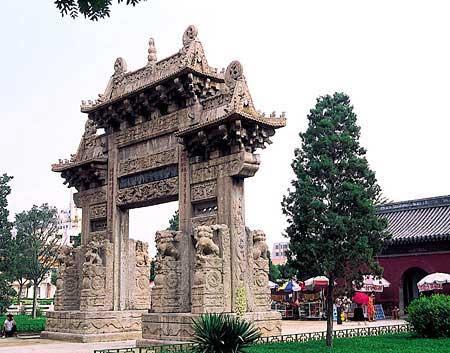
 |
| Mount Taishan(CNTV) |
Vegetations and ancient trees
Mount Taishan is rich in biological resources and its vegetation coverage rate reaches 80 percent. Stepping upwards from the foot of the mountain, visitors can see deciduous forests, mixed forests of conifers and broad-leaved species, coniferous forests, as well as alpine shrubs and grass. The vertical zonation makes clear the distinction between different forests, and the vegetation landscape is different from each other. Mount Taishan now has 989 species of spermatophytes belonging to 144 families, including 433 species of woody plants belonging to 72 families, 556 species of herbaceous plants belonging to 72 families, and 462 species of medicinal plants belonging to 111 families.
The ancient and famous trees on Mount Taishan were all produced by nature and have a long history. According to the “Historical Records,” “There are many trees on Mount Taishan, and nobody knows the exact number of tall trees that are too big for one person to get one’s arms around.” There are currently 34 species of trees with its total number standing at more than 10,000. These trees are closely connected with the historical and cultural development of Mount Taishan and are also the symbol of ancient civilizations. The famous trees include the Hanbai Linghan, Guayin Fenghou, Tanghuai Baozi, Qingtan Qiansui, Liuchao Yixiang, Yipin Dafu, Wudafu Pine, Wangren Pine, Ginkgo of the Song Dynasty, and Chinese wisteria which is over 100 years old. These trees, which bore witness to Chinese history, have gone through all hardships and become a part of our precious heritage.
Seasons of Mount Taishan
The seasons of Mount Taishan are also very attractive. When spring comes, everything comes back to life. Mount Taishan is covered by trees and grass again. The beautiful spring scenery attracts a large number of domestic and foreign visitors, and the red peach blossom, white apricot blossom, golden reinwardtia trigyna and forsythia flowers will be all over the branches. The locust trees on both sides of the Xi Stream bloom flowers one after another from lower altitudes to higher altitudes, and the flowers are as white as cotton and the smell is also very sweet. Furthermore, the large malus hupehensis open its buds, and the entire mountain seems to become a sea of flowers.
In the summer, the forests of Mount Taishan are hidden in clouds, and when the weather clears up, all the trees are fresh and green, and the vigorous vitality can be felt everywhere on the mountain. When the gentle wind blows across the pine forests in Duisong Mountain, there comes the beautiful sound of nature. No wonder Emperor Qianlong said that the most attractive place in Mount Taishan was the Duisong Mountain.
Autumn is the most colorful season on Mount Taishan. Seen from far away, the mountains and forests all glow with autumn tints. The leaves of smoke trees, acer monoes, and mountain ash trees are as red as fire, while the leaves of ginkgoes and lindens are as yellow as gold. The pines and cypresses are still green. The colors of oaks, planer trees, and maples are not as bright as before, but they also add to the beauty of the autumn in Mount Taishan. The winged euonymus appears red against the pines and cypresses. The Boston ivy, comparable with the winged euonymus, appears to be unnoticeable in the summer, but becomes really eye-catching in autumn, and the ivy either covers stones or fills ditches. With enchanting scenery, the mountain is like a strongly colored traditional Chinese painting.
The winter on Mount Taishan presents another different scene. The persistent pines and cypresses still stand on the top of the mountain and the tall and straight bamboo forests add some green to the mountain. After snow falls, the scenery becomes even more beautiful, for the whole mountain is covered by snow and seems to be wearing a silver and white coat. The green trees, red walls, yellow tiles, white snow, as well as the rare freshness and tranquility all make visitors feel relaxed and happy.

















 Wild Siberian tiger kills cattle in NE China
Wild Siberian tiger kills cattle in NE China


![]()
